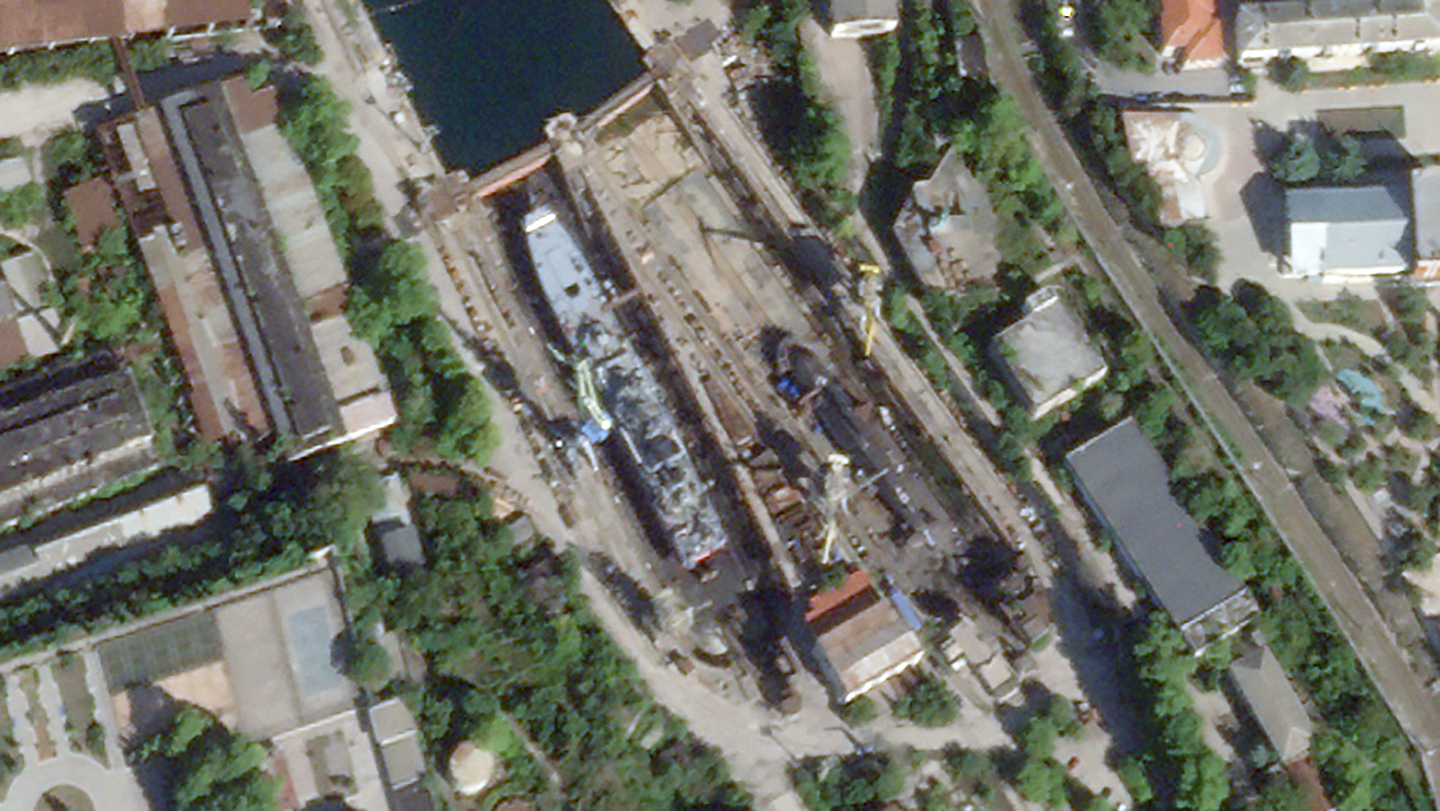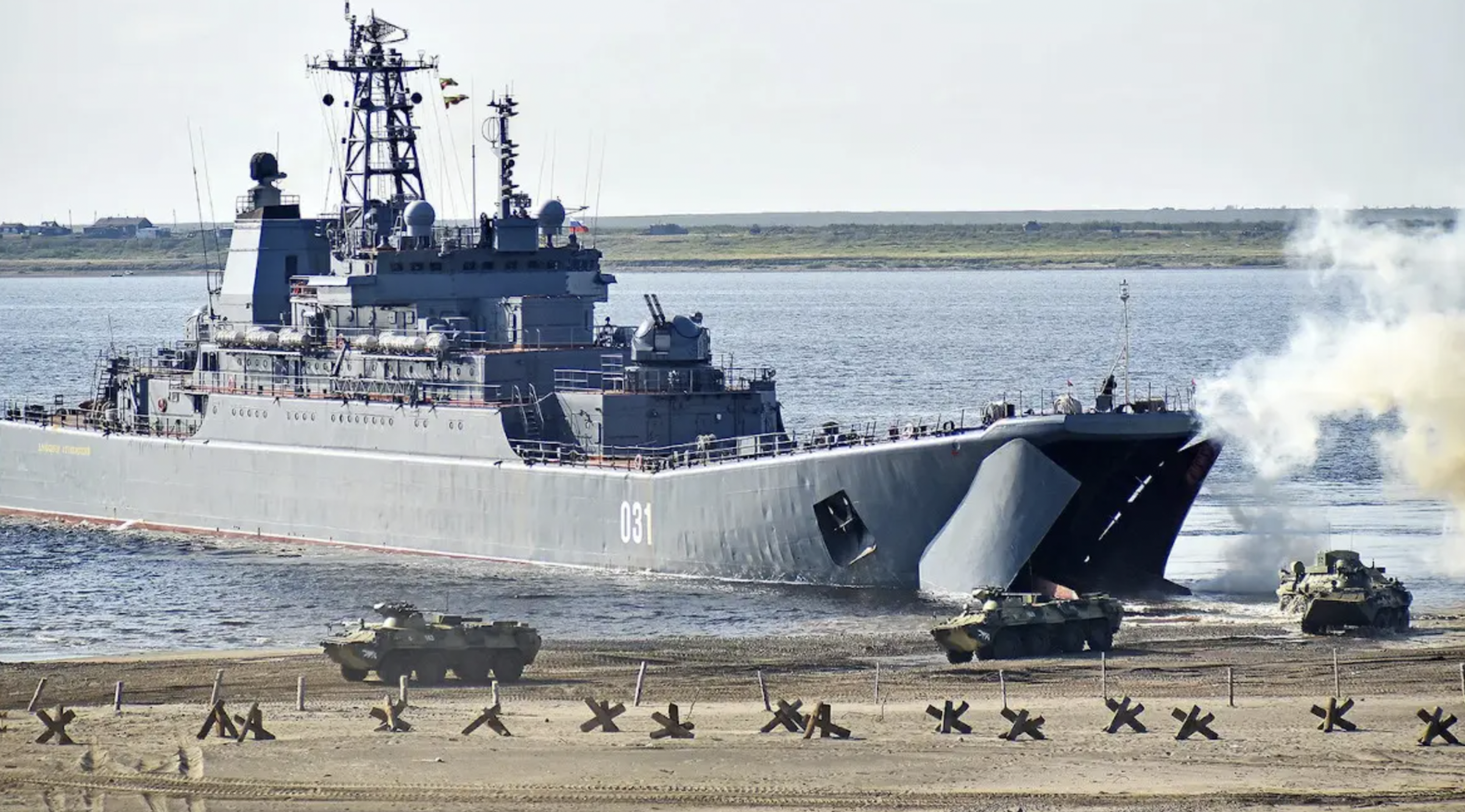A Ukrainian attack overnight on the port of Sevastopol, home to Russia’s Black Sea Fleet in Russian-occupied Crimea, struck a Russian submarine and a landing ship, according to the Russian Ministry of Defense. Videos and photos showed the port ablaze still this morning, after what the Russian defense ministry described as an attack using cruise missiles and unmanned surface vehicles (USVs, or drone boats).
Reuters reports that the Ukrainian military has said that its forces were responsible for hitting naval targets and port infrastructure in Sevastopol.
Multiple videos and photos on social media show the aftermath of the attack, with huge flames alongside the water at the port. Mikhail Razvozhayev, the Russian-installed governor of Sevastopol took to the Telegram messaging app to post a nighttime photo showing what appeared to be port infrastructure burning fiercely.
“As a result of being hit by enemy cruise missiles, two ships under repair were damaged,” the Russian Ministry of Defense said. According to multiple unconfirmed accounts, those two ships are reportedly the Kilo class diesel-electric attack submarine Rostov-on-Don (B-237) and the Ropucha class landing ship Minsk. However, in at least one case, the damage inflicted appears to be much more severe than the Russian account suggests.
While the status of the submarine at this point is unclear, photos showing the Ropucha class in dry dock reveal a significant degree of damage, especially to the superstructure, almost certainly sufficient for it to be declared a total hull loss.
Satellite imagery shows that, as of yesterday, both a Kilo class submarine and a Ropucha class landing ship were present in dry docks at Sevastopol, undergoing repairs. Meanwhile, at least one other Kilo was moored in a sub pen, and another Ropucha class ship was noted in the bay of Sevastopol, together with other amphibious warfare vessels.

According to H. I. Sutton, an undersea warfare analyst, the Kilo seen in the dry dock was likely a Project 636.3, or Improved Kilo, one of four active in the Black Sea. There is also the single Project 877 Alrosa, a revised Kilo design, with pump-jet propulsion, that you can read more about here.
Russian media reported that two people were killed in the attacks and another 26 wounded. Meanwhile, governor Razvozhayev said that “at least 24 people” had been injured.
“All emergency services are working on the site, there is no danger to civilian objects in the city,” Razvozhayev said.
According to the Russian Ministry of Defense, the attack involved 10 missiles and three USVs. The type of missiles used was not disclosed, although the most likely candidate appears to be air-launched Storm Shadow and/or SCALP-EG standoff missiles that can be launched by Ukrainian Air Force Su-24 Fencer strike/reconnaissance aircraft. The chief of the Ukrainian Air Force, Mykola Oleshchuk singled out his pilots for “excellent combat work,” pointing again to the likelihood of their involvement.
Meanwhile, a tweet today from the Ukrainian Air Force also provides a thinly veiled reference to the attack on Sevastopol, trolling Russia while stopping short of actually claiming responsibility.
In a statement on Telegram, the Russian defense ministry claims that seven of the missiles were successfully brought down by local air defenses and that all three USVs were destroyed by a patrol ship. Those claims cannot be independently verified, however.
As home to the Russian Black Sea Fleet in Crimea, the military and symbolic importance of the port of Sevastopol cannot be overstated.
Since Russia seized control of Crimea in 2014, the port has played an expanded role, including building and repairing warships and submarines.
Reflecting its strategic value, the port has repeatedly been targeted by Ukraine since the Kremlin launched its full-scale invasion of Ukraine.
Regardless of the damage to the ship and submarine, the fact that the dry dock facilities were targeted is significant since it will erode the already limited capacity for repairing naval vessels in Crimea. This includes even routine maintenance, which will have a knock-on effect on overall availability.

The apparent loss of a Ropucha class — a type that plays an important logistics function between Crimea and mainland Russia — and the potential removal of a Kilo class submarine, even if temporarily, would also be a serious blow for Moscow. The Kilo class has played an important role in firing Kalibr cruise missiles against targets in Ukraine.
How this will change Russia’s force-protection posture isn’t clear, but it appears to be the first use of cruise missiles to attack Russian warships in the harbor. As we have noted repeatedly in recent months, Russia has painted many of its warships based in Sevastopol to disrupt their silhouette in an attempt to fool cruise missiles’ infrared targeting seekers that use image matching for terminal guidance. These countermeasures first appeared right as Ukraine acquired and began using Storm Shadow cruise missiles, which use image/scene matching. Now, Ukraine has its own land attack cruise missile, a version of the Neptune, which is said to have a longer range than Storm Shadow and also uses an infrared seeker for terminal homing. This missile has been used to attack a key target in Crimea before, but not so far south on the peninsula. Regardless, now it appears Russia’s concerns about cruise missile attacks on their ships in port were well warranted.
So, if cruise missiles were indeed used, the Black Sea Fleet may now be in serious danger just sitting in its home port.
This is a developing story. Stay with The War Zone for updates.
Update, 11:00 am PST: The latest satellite imagery from Sevastopol indicates that both the Kilo class submarine and the Ropucha class landing ship sustained severe damage during the attack last night. Not only do the boats themselves appear to be burned-out, but the viability of the entire dry dock complex in which they were located now appears questionable.
Update, 1:00 pm PST: A Ukrainian military intelligence agency official has confirmed that, according to Kyiv, the Russian submarine and landing ship that were struck in Sevastopol overnight were likely to have been damaged beyond repair.
“Those are significant damages. We can now say that with a high probability they are not subject to restoration,” Andriy Yusov, the official, said in televised comments.
Contact the author: thomas@thedrive.com
